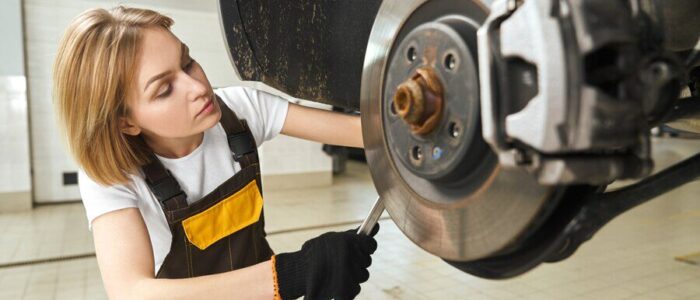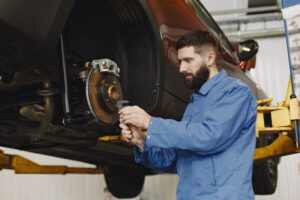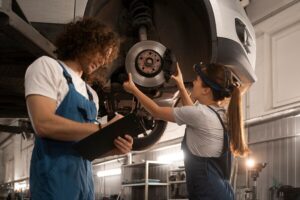
Maintaining your vehicle’s braking system is not just a matter of convenience; it’s a critical aspect of ensuring your safety on the road. When it comes to mastering brake repair, it’s about more than just fixing a squeak or replacing worn pads. It’s about understanding the intricate mechanics that enable your vehicle to stop efficiently and reliably, even in emergency situations. From diagnosing issues to performing precision repairs, the expertise required in brake repair is unparalleled. In this blog series, we delve deep into the world of brake systems, exploring common problems, best maintenance practices, and expert tips to keep you driving safely mile after mile.
Understanding Brake Components: An In-Depth Overview
The brake system of a vehicle is a complex assembly comprising several crucial components working in harmony to bring your car to a stop safely. From brake pads and rotors to calipers and brake lines, each part plays a vital role in the braking process. Understanding how these components interact allows you to diagnose issues effectively and appreciate the significance of proper maintenance. Whether it’s the hydraulic force of brake fluid or the friction generated by brake pads against rotors, every element contributes to the overall braking performance of your vehicle, making it essential to grasp their functions comprehensively.
Signs of Brake Trouble: When to Take Action
Recognizing the early warning signs of brake problems can be the difference between a minor repair and a potential safety hazard on the road. From squealing or grinding noises when braking to a soft or spongy brake pedal, these symptoms often indicate underlying issues within the braking system that require immediate attention. Ignoring such signs can lead to further damage, compromising your vehicle’s ability to stop efficiently and putting you and others at risk. Being proactive and addressing brake trouble as soon as it arises not only ensures your safety but also helps prevent more extensive and costly repairs down the line.
DIY Brake Maintenance: Tips for the At-Home Mechanic
Maintaining your vehicle’s brakes is crucial for safety, and DIY brake maintenance can save you money while ensuring optimal performance. Here are some essential tips for at-home mechanics:
- Regular Inspection: Periodically check your brake pads, rotors, and brake lines for wear and damage.
- Cleanliness Matters: Keep brake components clean to prevent buildup of debris and corrosion, which can affect performance.
- Lubricate Moving Parts: Apply brake grease to caliper sliders and other moving parts to ensure smooth operation.
- Check Brake Fluid: Monitor brake fluid levels and quality, and top up or replace as needed to maintain proper hydraulic function.
- Follow Manufacturer Guidelines: Always refer to your vehicle’s manual for specific maintenance procedures and torque specifications.
DIY brake maintenance can be a rewarding way to keep your car in top condition, but it’s crucial to follow proper procedures and safety precautions. By staying vigilant and addressing issues promptly, you can ensure your brakes are always ready to perform when you need them most.
The Importance of Brake Fluid: What You Need to Know
Brake fluid is often overlooked but plays a critical role in the operation of your vehicle’s braking system. It serves as the medium through which hydraulic pressure is transmitted from the brake pedal to the brakes, enabling them to engage effectively. Over time, brake fluid can become contaminated with moisture and debris, compromising its performance and putting your safety at risk. Regular inspection and replacement of brake fluid according to manufacturer recommendations are essential for maintaining optimal braking performance and preventing brake failure. Understanding the importance of brake fluid and its impact on your vehicle’s safety underscores the necessity of incorporating it into your regular maintenance routine.
Brake Pad Replacement: A Step-by-Step Guide
When it comes to maintaining your vehicle’s braking system, replacing worn brake pads is a crucial task that ensures your safety on the road. Here’s a step-by-step guide to help you navigate through the process:
- Prepare Your Vehicle: Safely lift and secure your vehicle on jack stands, ensuring stability before beginning any work.
- Remove Wheels: Take off the wheels to access the brake calipers and pads.
- Inspect Brake Components: Check for signs of wear or damage on the brake pads, rotors, and calipers.
- Replace Brake Pads: Carefully remove the old brake pads, paying attention to any clips or retaining pins.
- Reassemble and Test: Install the new brake pads, ensuring proper alignment and securing any retaining hardware. Once everything is reassembled, test the brakes to ensure they’re functioning correctly.
Replacing your brake pads is a straightforward but essential maintenance task that contributes to the overall safety and performance of your vehicle. By following these steps diligently, you can ensure optimal braking efficiency and peace of mind on the road.
Brake System Upgrades: Enhancing Safety and Performance
Upgrading your vehicle’s brake system can be a game-changer, enhancing both safety and performance on the road. By investing in high-quality components and advanced technology, you can significantly improve your braking capabilities, whether you’re navigating city streets or tackling challenging terrain. Upgrading your brake system isn’t just about stopping power; it’s also about responsiveness and reliability, giving you the confidence to push your vehicle to its limits without compromising safety. From high-performance brake pads to upgraded rotors and brake lines, there are several options to consider when it comes to enhancing your brake system.
- Improved Stopping Power: Upgraded components can provide shorter stopping distances, crucial for emergency situations.
- Reduced Brake Fade: Advanced materials and designs help dissipate heat more effectively, reducing the risk of brake fade during intense driving conditions.
- Enhanced Pedal Feel: Upgraded brake pads and lines can provide a firmer pedal feel, giving you better control over braking pressure.
- Increased Durability: High-quality materials and construction ensure that upgraded components can withstand the demands of aggressive driving and heavy loads.
- Customized Performance: Brake system upgrades allow you to tailor your vehicle’s braking performance to suit your driving style and preferences.
Investing in brake system upgrades is not just about enhancing performance; it’s about prioritizing safety and peace of mind on the road. With improved stopping power, reduced brake fade, and enhanced durability, upgrading your brake system is a smart investment for any vehicle enthusiast. Whether you’re looking to improve track performance or simply want added confidence during daily driving, consider upgrading your brake system to unlock its full potential.
Finding a Trustworthy Brake Repair Shop: Key Considerations
When it comes to brake repairs, finding a reputable and trustworthy auto shop is paramount to ensuring the safety and reliability of your vehicle. Start by researching local shops and reading reviews from other customers to gauge their reputation and level of service. Look for certifications and affiliations with reputable automotive organizations, which indicate a commitment to quality workmanship and customer satisfaction. Additionally, consider factors such as experience, pricing transparency, and warranty coverage when making your decision. A trustworthy brake repair shop will prioritize your safety and provide honest recommendations and reliable repairs, giving you confidence in your vehicle’s braking performance.
Conclusion
Understanding your vehicle’s brake system is essential for ensuring safety on the road. From recognizing signs of brake trouble to knowing when and how to perform maintenance, staying informed empowers you to keep your brakes in top condition. Whether you choose to tackle DIY maintenance or opt for professional assistance, prioritizing brake care is crucial for your well-being and that of others. If you’re in need of reliable brake repair services in Plainfield, IL, look no further than Last Chance Auto Repair. Our experienced team is committed to providing trustworthy repairs and exceptional service to keep you driving safely. Contact us today at 815-577-0327 or visit us at 12052 S Naper Plainfield Rd for all your brake repair needs. Don’t wait until it’s too late – ensure your brakes are in optimal condition with Last Chance Auto Repair.


